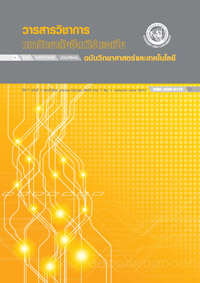การวิเคราะห์ด้านเศรษฐศาสตร์ของเครื่องอบแห้งกระดาษสา พลังงานแสงอาทิตย์
คำสำคัญ:
ระยะเวลาคืนทุน, ด้านเศรษฐศาสตร์, กระดาษสา, เครื่องอบแห้ง, พลังงานแสงอาทิตย์, payback period, economics, mulberry paper, dryers, solar energyบทคัดย่อ
งานวิจัยนี้มุ่งเน้นการวิเคราะห์ด้านเศรษฐศาสตร์ของเครื่องอบแห้งกระดาษสาพลังงานแสงอาทิตย์ที่พัฒนา กระบวนการผลิตกระดาษสาเพื่อให้สามารถผลิตกระดาษสาได้มากขึ้นโดยใช้เครื่องอบแห้งกระดาษสาแบบอุโมงค์ กว้าง 5 m ยาว 6 m สูง 2.5 m ที่มีการระบายอากาศแบบธรรมชาติเพื่อการลดระยะเวลาในการตากแห้ง ผลการ ทดสอบสมรรถนะของเครื่องอบแห้งกระดาษสาพลังงานแสงอาทิตย์จากการทดลองอบแห้งกระดาษสาพบว่า อุณหภูมิภายในเครื่องอบแห้งมีค่าเฉลี่ยประมาณ 40OC ที่สภาวะอุณหภูมิอากาศแวดล้อม 32OC ความเร็วอากาศ ภายในเครื่องอบแห้งมีค่าเฉลี่ยประมาณ 0.45 m/s ที่ค่าความเข้มรังสีอาทิตย์เฉลี่ย 743.5 W/m2 โดยที่กระดาษสา มีความชื้นเริ่มต้นร้อยละ 900 มาตรฐานแห้ง ลดลงเหลือความชื้นสุดท้ายประมาณร้อยละ 6.5 มาตรฐานแห้ง และใช้เวลาในการอบแห้ง 2 ชั่วโมงซึ่งใช้ระยะเวลาสั้นกว่าการตากแห้งแบบดั้งเดิมประมาณ 2 ชั่วโมง จากการทดสอบ ประสิทธิภาพของเครื่องอบแห้งกระดาษสาพลังงานแสงอาทิตย์พบว่ามีค่าเท่ากับ 53.14 % และใช้พลังงานในการ อบแห้งทั้งหมด 140.5 MJ ซึ่งคิดเป็น 4.53 MJ/kg H2Oevap ผลการวิเคราะห์จุดคุ้มทุนของเครื่องอบแห้งกระดาษสา ด้วยพลังงานแสงอาทิตย์ พิจารณามูลค่าเพิ่มที่ได้จากการใช้เครื่องอบแห้งเปรียบเทียบกับการตากธรรมชาติต่อพื้นที่ ขนาด 30 m2 สามารถตากได้ 64 แผ่น ภายใต้สมมุติฐานของการอบแห้งวันละ 2 ครั้ง อบแห้งกระดาษสาได้ 288 แผ่น มากกว่าการตากแห้งตามธรรมชาติ 224 แผ่น ผลกำไรสุทธิจากการผลิตกระดาษสา 2 บาท/แผ่น และทำการอบแห้ง 180 วันต่อปี จากราคาเครื่องอบแห้ง 30,000 บาท พบว่าจุดคุ้มทุนของการใช้เครื่องอบแห้งนี้มีค่าประมาณ 1 ปี 29 วัน
Analysis of the Economics of Mulberry Paper Solar Dryers
This research aims to analyze the economics of solar paper drying in the manufacturing of paper. A paper drying tunnel measuring 5 m wide, 2.5 m long and 6 m high can reduce drying time using natural ventilation. The process saves on costs thereby generating more profit for the company. Results of performance testing through solar experiments on air drying of paper revealed that with the temperature inside the dryer averaging 40OC, the ambient air temperature being 32OC, average speed of air dryers about 0.45 m/s and the average intensity of solar radiation at 743.5 W/m2; the paper moisture rate goes down from 900 percent to 6.5 percent reducing the drying time to two hours, shorter than the time when just exposed. Testing the efficiency of the drying chemical energy by traditional drying for about 2 hours resulted to 53.14% with the energy consumption totalling 140.5 MJ, which is 4.53 MJ/ kg H2Oevap. Analysing the cost of using the machine with solar drying mulberry paper, 64 sheets.can be exposed using the dryer with the natural drying space of 30 m2. Assuming that drying is done twice a day, the drying paper can accommodate 288 sheets compared to the 224 sheets by natural drying. Manufacturing of paper costs 2 baht / plate and drying is done 180 days per year using 30,000 dryers. The resulting expenses equates to the cost of using the drying paper for about a year and 29 days.






